Dental drill
A dental drill or handpiece is a hand-held, mechanical instrument used to perform a variety of common dental procedures, including removing decay, polishing fillings, and altering prostheses. The handpiece itself consists of internal mechanical components which initiate a rotational force and provide power to the cutting instrument, usually a dental burr. The type of apparatus used clinically will vary depending on the required function dictated by the dental procedure. It is common for a light source and cooling water-spray system to also be incorporated into certain handpieces; this improves visibility, accuracy and overall success of the procedure.
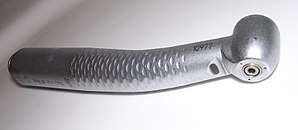
High-speed handpiece
High-speed handpieces work at cutting speeds over 180,000 rpm. They are technically categorised into Air Turbine and Speed-increasing depending on their mechanisms. In a clinical setting, however, Air turbine handpieces are most often referred to as "High-speeds". Handpieces have a chuck or collet, for holding a cutter, called a burr or bur.
Mechanisms
Power
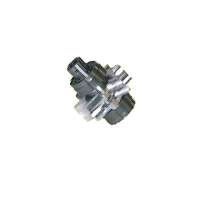
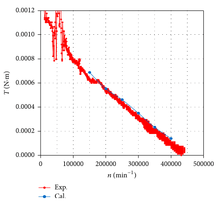
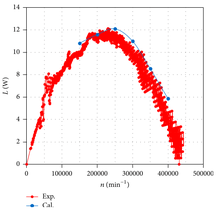
The turbine is powered by compressed air at about 35 pounds per square inch (~2,4 bar),[1] which passes up the centre of the instrument and rotates a windmill in the head of the handpiece. The centre of the windmill (chuck) is surrounded by bearing housing, which holds a friction-grip burr firmly & centrally within the instrument. Inside the bearing housing are small, lubricated ball-bearings (stainless steel or ceramic) which allow the shank of the burr to rotate smoothly along a central axis with minimal friction.
Failure of the burr to run centrally causes a number of clinical defects:
- The burr will judder; this will cause excessive, damaging vibrations leading to cracking and crazing in the material being cut. It is also an unpleasant experience for the patient.
- Eccentric cutting - this will result in irregular removal of the surface, meaning more tissue than necessary is removed.
- Decreased control - due to irregular cutting, it is more difficult for the Dentist to control movements
Cooling
The friction produced by high-speeds creates significant heat within the burr. It is therefore critical for high-speed handpieces to have an effective water-cooling system.
Illumination
Many modern handpieces now have a light in close proximity to the burr. The light is directed at the cutting surface as to assist with intra-operative vision.
Older handpieces used a system of halogen bulbs and fibre-optic rods, however, there are a number of disadvantages to this system: halogen bulbs deteriorate with time and are expensive to replace, and fibre-optic rods fracture easily if dropped and deteriorate during repeated autoclaving cycles.
More modern handpieces now use LED systems. Advantages of LEDs include a longer working life, more intense light and minimal heat production.
Speed-increasing handpiece
Electric motors cannot turn as fast as air turbines. To power a high-speed handpiece, gears are needed to increase the speed of an electric motor, often by a ratio of 1:5.[2] For this reason, electric handpieces are also called speed-increasing handpieces, working at cutting speeds over 180,000 rpm.[3]
- Speed-increasing handpiece is driven by electrical motor, also known as micromotor.
- The power to the handpiece is provided by the micromotor.
- Within the handpiece is internal gearings which allow the friction grip burr to rotate at a constant speed and torque.
- Therefore the power is provided by micromotor and internal gearings.
Torque
- Torque is the ability of burr to continually rotate and cut even when pressure is applied
- As the speed of a handpiece increases its torque subsequently decreases (slow-speed handpieces have high torque, whereas high-speed handpieces, like the air turbine system, have a low torque)
- The free running speed of 1:5 speed-increasing handpiece is the same as its cutting speed, thus 40,000 motor speed x5= 200,000 rpm burr speed.
- Electrical motor maintains the 200,000 rpm speed and provides consistent power so torque will be maintained.
Comparison of high speed and speed increasing handpieces
| High speed | Speed increasing | |
|---|---|---|
| Type of burr used | Friction grip | Friction grip |
| Power source | Compressed air | Electric Micromotor |
| Torque | Variable | Constant |
| Motion of burr | Rotation & Pecking | Rotation only |
| Balance | Usually neutral | Motor end heavy |
Slow speed handpiece
Slow speed handpieces work at a much slower rate that high speed and speed-increasing handpieces, and are usually driven by rotary vane motors, instead of air turbines. They work at a speed between 600 and 25,000 rpm. The internal gearings are very similar to that of a speed-increasing handpiece. The main difference between the two is that slow speed has internal gearing and they use a latch grip burr as opposed to a friction grip burr.
Indications for use
Generally used for operative procedures such as the removal of dental caries or for polishing enamel or restorative materials. Straight slow speed handpiece is generally indicated for the extra oral adjustment and polishing of acrylic and metals.
Speed decreasing handpiece
Designed to work at slower speeds.
Indications for use
The main indications for use include endodontic canal preparation, implant placement and prophylaxis.
Endodontic canal preparation
Endodontic canals are prepared using a slow rotating file. It is imperative that torque is controlled in order to prevent endodontic file separation during use.
- Implant placement - In order to prevent heat damage to bone during implant placement speed decreasing handpiece is used.
- Prophylaxis - Prophylaxis with the use of speed decreasing handpiece ensures that less heat is produced and thus less risk of pulpal damage by heat transmission.
Dental burr
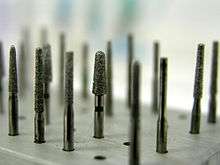
A dental burr is a type of burr used in a handpiece. The burrs are usually made of tungsten carbide or diamond. The three parts to a burr are the head, the neck, and the shank.[4]
The heads of some burrs (such as tungsten carbide burrs) contain the blades which remove material. These blades may be positioned at different angles in order to change the property of the burr. More obtuse angles will produce a negative rake angle which increases the strength and longevity of the burr. More acute angles will produce a positive rake angle which has a sharper blade, but which dulls more quickly. The heads of other commonly used burrs are covered in a fine grit which has a similar cutting function to blades (e.g. high speed diamond burrs).
There are various shapes of burrs that include round, inverted cone, straight fissure, tapered fissure, and pear-shaped burrs. Additional cuts across the blades of burrs were added to increase cutting efficiency, but their benefit has been minimized with the advent of high-speed handpieces.[4] These extra cuts are called crosscuts.
Due to the wide array of different burrs, numbering systems to categorise burrs are used and include a US numbering system and a numbering system used by the International Organisation for Standardisation (ISO).
Maintenance
The instrument needs to be disinfected after every usage to prevent infection during succeeding incisions. Due to the mechanical structure of the device, this must not be done with alcoholic disinfectant, as that would destroy the lubricants. Instead it has to be done in an autoclave after removing the drill, washing the instrument with water and lubricating it.[5][6] The United States Food and Drug Administration classes burrs as "single-use devices",[7] although they can be sterilised with proper procedures.
History

The Indus Valley Civilization has yielded evidence of dentistry being practiced as far back as 7000 BC.[8] This earliest form of dentistry involved curing tooth related disorders with bow drills operated, perhaps, by skilled bead craftsmen.[9] The reconstruction of this ancient form of dentistry showed that the methods used were reliable and effective.[10] Cavities of 3.5 mm depth with concentric grooves indicate use of a drill tool. The age of the teeth has been estimated at 9000 years. In later times, mechanical hand drills were used. Like most hand drills, they were quite slow, with speeds of up to 15 rpm. In 1864, British dentist George Fellows Harrington invented a clockwork dental drill named Erado.[11] The device was much faster than earlier drills, but also very noisy. In 1868, American dentist George F. Green came up with a pneumatic dental drill powered with pedal-operated bellows. James B. Morrison devised a pedal-powered burr drill in 1871.
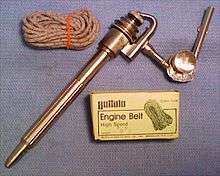
The first electric dental drill was patented in 1875 by Green, a development that revolutionized dentistry. By 1914, electric dental drills could reach speeds of up to 3000 rpm. A second wave of rapid development occurred in the 1950s and 60s, including the development of the air turbine drill.
The modern incarnation of the dental drill is the air turbine (or air rotor) handpiece, developed by John Patrick Walsh (later knighted) and members of the staff of the Dominion Physical Laboratory (DPL) Wellington, New Zealand. The first official application for a provisional patent for the handpiece was granted in October 1949. This handpiece was driven by compressed air. The final model is held by the Commonwealth Inventions development Board in Canada. The New Zealand patent number is No/104611. The patent was granted in November to John Patrick Walsh who conceived the idea of the contra angle air-turbine handpiece after he had used a small commercial-type air grinder as a straight handpiece. Dr. John Borden developed it in America and it was first commercially manufactured and distributed by the DENTSPLY Company as the Borden Airotor in 1957. Borden Airotors soon were also manufactured by different other companies like KaVo Dental, which built their first one in 1959.[12]
Current iterations can operate at up to 800,000 rpm, however, most common is a 400,000 rpm "high speed" handpiece for precision work complemented with a "low speed" handpiece operating at a speed that is dictated by a micromotor which creates the momentum (max up to 40,000 rpm) for applications requiring higher torque than a high-speed handpiece can deliver.[13]
Alternatives
Starting in the 1990s, a number of alternatives to conventional rotary dental drills have been developed. These include laser ablation systems[14] and air abrasion devices (essentially miniature sand blasters) or dental treatments with ozone.
References
- "Highspeed Handpiece Design". American Dental Accessories. May 25, 2010. Retrieved October 16, 2018.
- Gregori M. Kurtzman (February 2007). "Electric Handpieces: An Overview of Current Technology". Inside Dentistry. AEGIS Communications. 3 (2). Retrieved October 15, 2018.
- Bonsor, Pearson (2013). A clinical guide to applied dental materials. Churchill Livingstone Elsevier. p. 329.
- Summit, James B., J. William Robbins, and Richard S. Schwartz. "Fundamentals of Operative Dentistry: A Contemporary Approach." 2nd edition. Carol Stream, Illinois, Quintessence Publishing Co, Inc, 2001. Pages 139 - 143. ISBN 0-86715-382-2.
- "Maintenance Instruction for Dental Drills (Italian)"
- "Hygiene Instructions for Dentists (German)"
- Mary Govoni (October 15, 2014). "Reusing disposable items: saving money or risking cross-contamination?". www.dentaleconomics.com. Retrieved 2017-03-02.
- Coppa, A. et al. 2006. Early Neolithic tradition of dentistry. Nature. Volume 440. 6 April 2006. doi:10.1038/440755a
- "Stone age man used dentist drill". BBC News. 6 April 2006.
- NBC News (2008). Dig uncovers ancient roots of dentistry.
- "BDA Museum: Collections: Dental equipment: Clockwork drill and dental engine". British Dental Association. 7 June 2013. Retrieved 9 September 2015.
- History of Dental Turbines Archived 2015-04-28 at Archive.today
- Handpiece, Use, Care and Maintenance", Franzel, Mattana. University Detroit Mercy School of Dentistry literature 2007
- Johannes, Laura (2013-04-29). "To Cut Tooth Decay: A Laser vs. a Drill". Wall Street Journal. ISSN 0099-9660. Retrieved 2016-09-20.
- MedTerms definition for Drill, dental
- "Dental drills - enemy of the people?" from the British Dental Association museum
- Australian Dental Journal:1 p59-62
| Wikimedia Commons has media related to Dental drills and bits. |